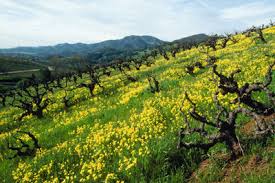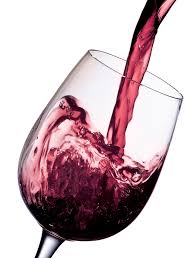As I'm a proponent of the "Old Vine Zinfandel" I had to post this news article coming out of North Carolina. I guess you can't necessarily say that old vines make
better wines - they make
different wines. I was at a conference 2 years ago that explained, for Zinfandel, as the vines age, an internal virus that proliferates in the later years often leads to the development of more floral, complex Zinfandel wines. I guess I, as a wine consumer, appreciate those differences compared to the zippy, spicy, fruity, big Zinfandels (from California... I should definitely state where I'm buying my Old Vine Zins...).
Old Vines in CA
(Photo from Google Images)
But I used to get this question a lot during my graduate years because, for some unknown reason, we all drank a lot of Zin. I guess it is the variety of choice to match with bar-b-q's and grilled hamburgers. Perhaps that's why we were all enjoying a glass of this zesty wine variety that is sure to kick you up a notch on life. :)
Is that Zin in there???
(Photo from Google Images)
But the "Old Vine" marketing can be put on several varieties. It is not unique to Zin - it's just that we see a lot more "Old Vine Zin" coming out of specific regions. Anyway, I'm getting off topic. I hope you enjoy this article as I did.
Dry Creek Vineyard's "Old Vine" Label
(Photo from Google Images)
This article was originally posted at
Charolette Observer. It is pasted here for your convenience.
Do older vines really lead to better wine?
Most wine lovers think they do, but the truth isn't so simple.
By Catherine Rabb
At a recent tasting, wine lovers were discussing the quality of North Carolina wines. The consensus was that the wines get better every year.
Good news for our hardworking producers. One recurring comment, though, was how young the N.C. vines are, and how much better the wine will be when those vines are a couple of decades old.
The vines in question are vitis vinifera, or the species of grapes used for fine winemaking. These are wines with names we recognize, such as cabernet sauvignon and chardonnay. Although native grape species like muscadine have been here forever, the big explosion of plantings of vitis vinifera is fairly recent in North Carolina, most within the last decade.
I'd like to think everything gets better with age, but the real answer may be a bit more elusive.
While this question might be better answered by a botanist and can't be covered completely in a short column, perhaps I can start the discussion.
The first question is: How old is old? It takes about three years from the time a vine is planted to the time the fruit can be used in wine. The idea is to force the vine to develop a large underground root system that delivers enough minerals and nutrients to the growing leaf system so photosynthesis can occur.
During photosynthesis, the energy from the sun is used by the vine's green tissue to convert carbon dioxide to sugars. These components are transferred to the grapes. The grape grower must wait until the vine is 5 or 6 years old to see the full quality. From this time until the vine is about 25, it is in full production, barring diseases or pests.
You might think there is universal consensus about what constitutes a mature or older vine. That is not the case. While the term "Old Vine" has significant marketing power, at least here in the U.S., it means nothing in legal terms. But there is a sort of handshake agreement among producers that an old vine should be roughly 40 years old. There are places around the world like the Barossa in Australia, Burgundy in France and Chianti in Italy where older vines are prized.
A healthy vine can grow for about a century. But the older the vine, the more its production slows. As a vine gets older, it produces less and less fruit. Older vines are often replaced because it's no longer financially viable to allow them to take up vineyard space.
Still, a vine that produced exceptional fruit might be worth keeping. Even though an older vine might yield less fruit, it is likely to develop a very deep root system because, basically, it has a lot of practice. A successful old vine is one that has found its home and steadily delivers harvest after harvest.
Even though the production is lower, growers may keep old vines because they make great wine, reliably and consistently. Older vines might be better able to resist drought or a very wet season due to that established root system, and the fruit tends to ripen earlier. Like all of us who are getting older, reduced circulation limits the amount of water and nutrients available to the vine. That means lower yields and smaller berries, but more concentrated fruit.
Does an older vine make a better wine? There are plenty of growers who feel the quality of the wine is not dependent on a vine's age. Famed viticulturalist Dr. Richard Smart says it's more about the management of the canopy (the vigorous leaf growth during the growing season) than the age of the vine. In 1976, Stag's Leap Wine Cellars 1973 Cabernet Sauvignon beat out top French competitors with wine from 3-year-old vines.
Are older vines better? Maybe. Maybe not. It seems to me that good winemakers value all good-quality fruit in the quest to make good wine. Winemakers might find characteristics to appreciate in the fruit of both older and younger vines.
Catherine Rabb is co-owner of Fenwick's and a senior instructor at Johnson & Wales University. E-mail: Catherine.Rabb@jwu.edu




No comments:
Post a Comment